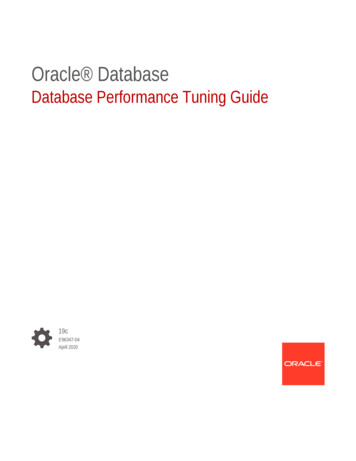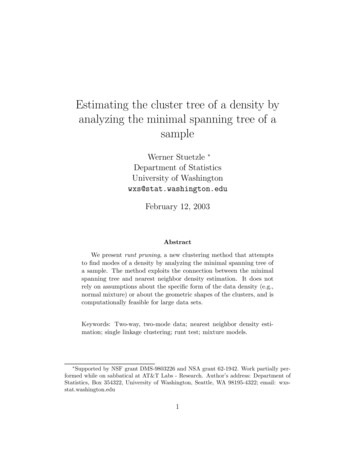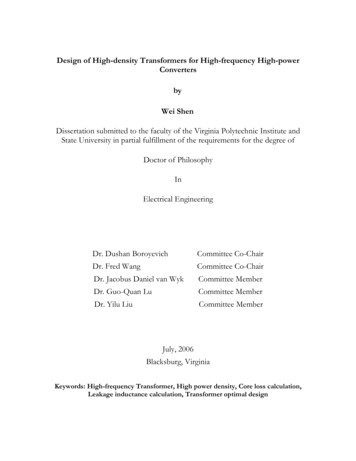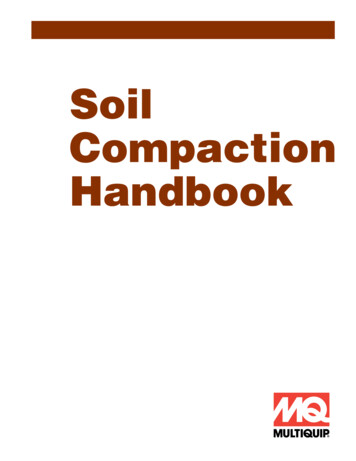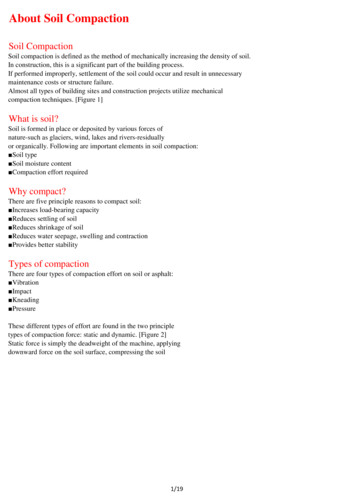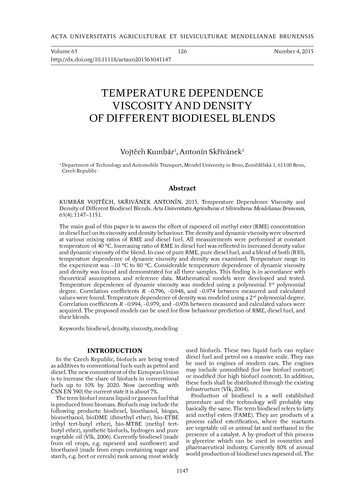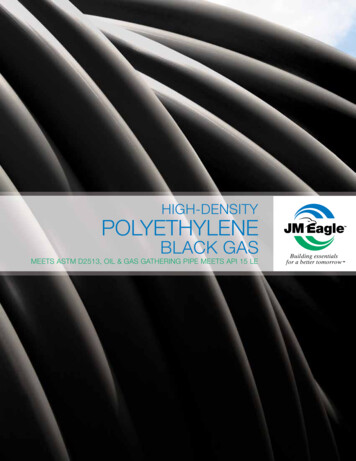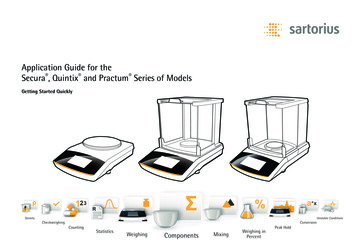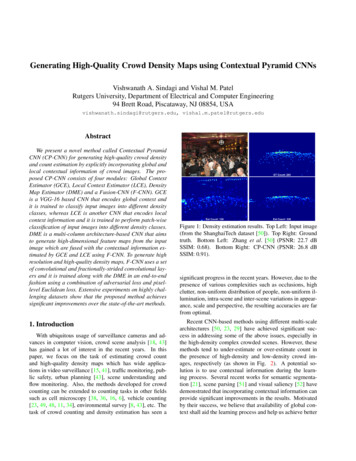
Transcription
Generating High-Quality Crowd Density Maps using Contextual Pyramid CNNsVishwanath A. Sindagi and Vishal M. PatelRutgers University, Department of Electrical and Computer Engineering94 Brett Road, Piscataway, NJ 08854, USAvishwanath.sindagi@rutgers.edu, vishal.m.patel@rutgers.eduAbstractWe present a novel method called Contextual PyramidCNN (CP-CNN) for generating high-quality crowd densityand count estimation by explicitly incorporating global andlocal contextual information of crowd images. The proposed CP-CNN consists of four modules: Global ContextEstimator (GCE), Local Context Estimator (LCE), DensityMap Estimator (DME) and a Fusion-CNN (F-CNN). GCEis a VGG-16 based CNN that encodes global context andit is trained to classify input images into different densityclasses, whereas LCE is another CNN that encodes localcontext information and it is trained to perform patch-wiseclassification of input images into different density classes.DME is a multi-column architecture-based CNN that aimsto generate high-dimensional feature maps from the inputimage which are fused with the contextual information estimated by GCE and LCE using F-CNN. To generate highresolution and high-quality density maps, F-CNN uses a setof convolutional and fractionally-strided convolutional layers and it is trained along with the DME in an end-to-endfashion using a combination of adversarial loss and pixellevel Euclidean loss. Extensive experiments on highly challenging datasets show that the proposed method achievessignificant improvements over the state-of-the-art methods.1. IntroductionWith ubiquitous usage of surveillance cameras and advances in computer vision, crowd scene analysis [18, 43]has gained a lot of interest in the recent years. In thispaper, we focus on the task of estimating crowd countand high-quality density maps which has wide applications in video surveillance [15, 41], traffic monitoring, public safety, urban planning [43], scene understanding andflow monitoring. Also, the methods developed for crowdcounting can be extended to counting tasks in other fieldssuch as cell microscopy [38, 36, 16, 6], vehicle counting[23, 49, 48, 11, 34], environmental survey [8, 43], etc. Thetask of crowd counting and density estimation has seen aFigure 1: Density estimation results. Top Left: Input image(from the ShanghaiTech dataset [50]). Top Right: Groundtruth. Bottom Left: Zhang et al. [50] (PSNR: 22.7 dBSSIM: 0.68). Bottom Right: CP-CNN (PSNR: 26.8 dBSSIM: 0.91).significant progress in the recent years. However, due to thepresence of various complexities such as occlusions, highclutter, non-uniform distribution of people, non-uniform illumination, intra-scene and inter-scene variations in appearance, scale and perspective, the resulting accuracies are farfrom optimal.Recent CNN-based methods using different multi-scalearchitectures [50, 23, 29] have achieved significant success in addressing some of the above issues, especially inthe high-density complex crowded scenes. However, thesemethods tend to under-estimate or over-estimate count inthe presence of high-density and low-density crowd images, respectively (as shown in Fig. 2). A potential solution is to use contextual information during the learning process. Several recent works for semantic segmentation [21], scene parsing [51] and visual saliency [52] havedemonstrated that incorporating contextual information canprovide significant improvements in the results. Motivatedby their success, we believe that availability of global context shall aid the learning process and help us achieve better
Figure 2: Average estimation errors across various density levels. Current state-of-the-art method [50] overestimates/underestimates count in the presence of lowdensity/high-density crowd.count estimation. In addition, existing approaches employmax-pooling layers to achieve minor translation invarianceresulting in low-resolution and hence low-quality densitymaps. Also, to the best of our knowledge, most existingmethods concentrate only on the quality of count rather thanthat of density map. Considering these observations, wepropose to incorporate global context into the learning process while improving the quality of density maps.To incorporate global context, a CNN-based Global Context Estimator (GCE) is trained to encode the context ofan input image that is eventually used to aid the densitymap estimation process. GCE is a CNN-based on VGG16 architecture. A Density Map Estimator (DME), whichis a multi-column architecture-based CNN with appropriate max-pooling layers, is used to transform the image intohigh-dimensional feature maps. Furthermore, we believethat use of local context in the image will guide the DME toestimate better quality maps. To this effect, a Local ContextEstimator CNN (LCE) is trained on input image patches toencode local context information. Finally, the contextualinformation obtained by LCE and GCE is combined withthe output of DME using a Fusion-CNN (F-CNN). Notingthat the use of max-pooling layers in DME results in lowresolution density maps, F-CNN is constructed using a setof fractionally-strided convolutions [22] to increase the output resolution, thereby generating high-quality maps. In afurther attempt to improve the quality of density maps, theF-CNN is trained using a weighted combination of pixelwise Euclidean loss and adversarial loss [10]. The use ofadversarial loss helps us combat the widely acknowledgeissue of blurred results obtained by minimizing only the Euclidean loss [13].The proposed method uses CNN networks to estimatecontext at various levels for achieving lower count error andbetter quality density maps. It can be considered as a set ofCNNs to estimate pyramid of contexts, hence, the proposedmethod is dubbed as Contextual Pyramid CNN (CP-CNN).To summarize, the following are our main contributions: We propose a novel Contextual Pyramid CNN (CPCNN) for crowd count and density estimation that encodes local and global context into the density estimation process. To the best of our knowledge, ours is the first attempt toconcentrate on generating high-quality density maps.Also, in contrast to the existing methods, we evaluate the quality of density maps generated by the proposed method using different quality measures such asPSNR/SSIM and report state-of-the-art results. We use adversarial loss in addition to Euclidean lossfor the purpose of crowd density estimation. Extensive experiments are conducted on three highlychallenging datasets ([50, 44, 12]) and comparisonsare performed against several recent state-of-the-artapproaches. Further, an ablation study is conducted todemonstrate the improvements obtained by includingcontextual information and adversarial loss.2. Related workVarious approaches have been proposed to tackle theproblem of crowd counting in images [12, 5, 16, 44, 50]and videos [2, 9, 26, 7]. Initial research focussed on detection style [17] and segmentation framework [35]. Thesemethods were adversely affected by the presence of occlusions and high clutter in the background. Recent approachescan be broadly categorized into regression-based, densityestimation-based and CNN-based methods. We briefly review various methods among these cateogries as follows:Regression-based approaches. To overcome the issuesof occlusion and high background clutter, researchers attempted to count by regression where they learn a mappingbetween features extracted from local image patches to theircounts [3, 27, 6]. These methods have two major components: low-level feature extraction and regression modeling.Using a similar approach, Idrees et al. [12] fused count frommultiple sources such as head detections, texture elementsand frequency domain analysis.Density estimation-based approaches. While regressionbased approaches were successful in addressing the issuesof occlusion and clutter, they ignored important spatial information as they were regressing on the global count. Lempitsky et al. [16] introduced a new approach of learninga linear mapping between local patch features and corresponding object density maps using regression. Observingthat it is difficult to learn a linear mapping, Pham et al. in[24] proposed to learn a non-linear mapping between local patch features and density maps using a random forestframework. Many recent approaches have proposed methods based on density map regression [38, 42, 40]. A morecomprehensive survey of different crowd counting methods
Figure 3: Overview of the proposed CP-CNN architecture.The network incorporates global and local context usingGCE and LCE respectively. The context maps are concatenated with the output of DME and further processed by FCNN to estimate high-quality density maps.can be found in [33, 6, 18, 28].CNN-based methods. Recent success of CNN-based methods in classification and recognition tasks has inspired researchers to employ them for the purpose of crowd counting and density estimation [37, 44, 36, 30]. Walach et al.[36] used CNNs with layered training approach. In contrast to the existing patch-based estimation methods, Shanget al. [30] proposed an end-to-end estimation method usingCNNs by simultaneously learning local and global counton the whole sized input images. Zhang et al. [50] proposed a multi-column architecture to extract features at different scales. Similarly, Onoro-Rubio and López-Sastre in[23] addressed the scale issue by proposing a scale-awarecounting model called Hydra CNN to estimate the objectdensity maps. Boominathan et al. in [1] proposed to tacklethe issue of scale variation using a combination of shallowand deep networks along with an extensive data augmentation by sampling patches from multi-scale image representations. Marsden et al. explored fully convolutional networks [19] and multi-task learning [20] for the purpose ofcrowd counting.Inspired by cascaded multi-task learning [25, 4], Sindagiet al. [32] proposed to learn a high-level prior and perform density estimation in a cascaded setting. In contrast to[32], the work in this paper is specifically aimed at reducingoverestimation/underestimation of count error by systemically leveraging context in the form of crowd density levels at various levels using different networks. Additionally,we incorporate several elements such as local context andadversarial loss aimed at improving the quality of densitymaps. Most recently, Sam et al. [29] proposed a SwitchingCNN network that intelligently chooses the most optimalregressor among several independent regressors for a particular input patch. A comprehensive survey of recent cnnbased methods for crowd counting can be found in [33].Recent works using multi-scale and multi-column architectures [50, 23, 36] have demonstrated considerable success inachieving lower count errors. We make the following observations regarding these recent state-of-the-art approaches:1. These methods do not explicitly incorporate contextual information which is essential for achieving further improvements. 2. Though existing approaches regress on density maps, they are more focussed on improving count errors rather than quality of the density maps, and 3. Existing CNN-based approaches are trained using a pixel-wiseEuclidean loss which results in blurred density maps. Inview of these observations, we propose a novel method tolearn global and local contextual information from imagesfor achieving better count estimates and high-quality density maps. Furthermore, we train the CNNs in a GenerativeAdversarial Network (GAN) based framework [10] to exploit the recent success of adversarial loss to achieve highquality and sharper density maps.3. Proposed method (CP-CNN)The proposed CP-CNN method consists of a pyramidof context estimators and a Fusion-CNN as illustrated inFig. 3. It consists of four modules: GCE, LCE, DME,and F-CNN. GCE and LCE are CNN-based networks thatencode global and local context present in the input image respectively. DME is a multi-column CNN that performs the initial task of transforming the input image tohigh-dimensional feature maps. Finally, F-CNN combinescontextual information from GCE and LCE with highdimensional feature maps from DME to produce highresolution and high-quality density maps. These modulesare discussed in detail as follows.3.1. Global Context Estimator (GCE)As discussed in Section 1, though recent state-of-the-artmulti-column or multi-scale methods [50, 23, 36] achievesignificant improvements in the task of crowd count estimation, they either underestimate or overestimate counts inhigh-density and low-density crowd images respectively (asexplained in Fig. 2). We believe it is important to expliciltymodel context present in the image to reduce the estimationerror. To this end, we associate global context with the levelof density present in the image by considering the task oflearning global context as classifying the input image intofive different classes: extremely low-density (ex-lo), lowdensity (lo), medium-density (med), high-density (hi) andextremely high-density (ex-hi). Note that the number ofclasses required is dependent on the crowd density variation in the dataset. A dataset containing large variationsmay require higher number of classes. In our experiments,we obtained significant improvements using five categoriesof density levels.In order to learn the classification task, a VGG-16 [31]based network is fine-tuned with the crowd training data.Network used for GCE is as shown in Fig. 4. The convolutional layers from the VGG-16 network are retained,however, the last three fully connected layers are replaced
with a different configuration of fully connected layers inorder to cater to our task of classification into five categories. Weights of the last two convolutional layers are finetuned while keeping the weights fixed for the earlier layers.The use of pre-trained VGG network results in faster convergence as well as better performance in terms of contextestimation.Figure 4: Global context estimator based on VGG-16 architecture. The network is trained to classify the input imagesinto various density levels thereby encoding the global context present in the image.3.2. Local Context Estimator (LCE)Existing methods for crowd density estimation have primarily focussed on achieving lower count errors rather thanestimating better quality density maps. As a result, thesemethods produce low-quality density maps as shown in Fig.1. After an analysis of these results, we believe that somekind of local contextual information can aid us to achievebetter quality maps. To this effect, similar to GCE, we propose to learn an image’s local context by learning to classify it’s local patches into one of the five classes: {ex-lo, lo,med, hi, ex-hi}. The local context is learned by the LCEwhose architecture shown in Fig. 5. It is composed of aset of convolutional and max-pooling layers followed by 3fully connected layers with appropriate drop-out layers after the first two fully connected layers. Every convolutionaland fully connected layer is followed by a ReLU layer except for the last fully connected layer which is followed bya sigmoid layer.LCE. Estimating density maps from high-density crowd images is especially challenging due to the presence of headswith varying sizes in and across images. Previous workson multi-scale [23] or multi-column [50] architectures havedemonstrated abilities to handle the presence of considerably large variations in object sizes by achieving significantimprovements in such scenarios. Inspired by the successof these methods, we use a multi-column architecture similar to [50]. However, notable differences compared to theirwork are that our columns are much deeper and have different number of filters and filter sizes that are optimized forlower count estimation error. Also, in this work, the multicolumn architecture is used to transform the input into aset of high-dimensional feature map rather than using themdirectly to estimate the density map. Network details forDME are illustrated in Fig. 6.It may be argued that since the DME has a pyramid offilter sizes, one may be able to increase the filter sizes andnumber of columns to address larger variation in scales.However, note that addition of more columns and the filter sizes will have to be decided based on the scale variationpresent in the dataset, resulting in new network designs thatcater to different datasets containing different scale variations. Additionally, deciding the filter sizes will requiretime consuming experiments. With our network, the designremains consistent across all datasets, as the context estimators can be considered to perform the task of coarse crowdcounting.Figure 6: Density Map Estimator: Inspired by Zhang et al.[50], DME is a multi-column architecture. In contrast to[50], we use slightly deeper columns with different numberof filters and filter sizes.Figure 5: Local context estimator: The network is trainedto classify local input patches into various density levelsthereby encoding the local context present in the image.3.3. Density Map Estimator (DME)The aim of DME is to transform the input image into aset of high-dimensional feature maps which will be concatenated with the contextual information provided by GCE and3.4. Fusion-CNN (F-CNN)The contextual information from GCE and LCE are combined with the high-dimensional feature maps from DMEusing F-CNN. The F-CNN automatically learns to incorporate the contextual information estimated by context estimators. The presence of max-pooling layers in the DME network (which are essential to achieve translation invariance)results in down-sampled feature maps and loss of details.
Since, the aim of this work is to estimate high-resolutionand high-quality density maps, F-CNN is constructed usinga set of convolutional and fractionally-strided convolutionallayers. The set of fractionally-strided convolutional layershelp us to restore details in the output density maps. Thefollowing structure is used for F-CNN: CR(64,9)-CR(32,7)TR(32)-CR(16,5)-TR(16)-C(1,1), where, C is convolutionallayer, R is ReLU layer, T is fractionally-strided convolutionlayer and the first number inside every brace indicates thenumber of filters while the second number indicates filtersize. Every fractionally-strided convolution layer increasesthe input resolution by a factor of 2, thereby ensuring thatthe output resolution is the same as that of input.Once the context estimators are trained, DME and FCNN are trained in an end-to-end fashion. Existing methods for crowd density estimation use Euclidean loss to traintheir networks. It has been widely acknowledged that minimization of L2 error results in blurred results especially forimage reconstruction tasks [13, 14, 45, 46, 47]. Motivatedby these observations and the recent success of GANs forovercoming the issues of L2-minimization [13], we attemptto further improve the quality of density maps by minimizing a weighted combination of pixel-wise Euclidean lossand adversarial loss. The loss for training F-CNN and DMEis defined as follows:LT LE λa LA ,LE W H1 XXkφ(X w,h ) (Y w,h )k2 ,W H w 1(1)(2)h 1LA log(φD (φ(X)),(3)where, LT is the overall loss, LE is the pixel-wise Euclidean loss between estimated density map and it’s corresponding ground truth, λa is a weighting factor, LAis the adversarial loss, X is the input image of dimensions W H, Y is the ground truth density map, φis the network consisting of DME and F-CNN and φDis the discriminator sub-network for calculating the adversarial loss. Following structure is used for the discriminator sub-network: igmoid, where C representsconvolutional layer, P represents PReLU layer and M ismax-pooling layer.4. Training and evaluation detailsIn this section, we discuss details of the training and evaluation procedures.Training details: Let D be the original training dataset.Patches 1/4th the size of original image are cropped from100 random locations from every image in D. Other augmentation techniques like horizontal flipping and noise addition are used to create another 200 patches. The randomcropping and augmentation resulted in a total of 300 patchesper image in the training dataset. Let this set of images becalled as Ddme . Another training set Dlc is formed by cropping patches of size 64 64 from 100 random locations inevery training image in D.GCE is trained using the dataset Ddme . The corresponding ground truth categories for each image is determinedbased on the number of people present in it. Note that theimages are resized to 224 224 before feeding them intothe VGG-based GCE network. The network is then trainedusing the standard cross-entropy loss. LCE is trained usingthe 64 64 patches in Dlc . The ground truth categories ofthe training patches is determined based on the number ofpeople present in them. The network is then trained usingthe standard cross-entropy loss.Next, the DME and F-CNN networks are trained inan end-to-end fashion using input training images fromDdme and their corresponding global and local contexts1 .i) for an input training image X iThe global context (Fgcis obtained in the following way. First, an empty globalicontext Fgcof dimension 5 Wi /4 Hi /4 is created,where Wi Hi is the dimension of Xi . Next, a set ofi,j(j 1.5) is obtained by feedingclassification scores ygci,jisXi to GCE. Each feature map in global context Fgcthen filled with the corresponding classification scoreygi,j . The local context (Flci ) for X i is obtained in thefollowing way. An empty local context Flci of dimension5 Wi Hi is first created. A sliding window classifier(LCE) of size 64 64 is run on Xi to obtain the classii,j,wfication score ylc(j 1.5) where w is the windowi,j,wlocation. The classification scores ylcare used to fillthe corresponding window location w in the respectivei,ji,jis then resized to a size of. Fgclocal context map FgcWi /4 Hi /4. After the context maps are estimated, Xiis fed to DME to obtain a high-dimensional feature mapiiand Flci . TheseFdmewhich is concatenated with Fgcconcatenated feature maps are then fed into F-CNN. Thetwo CNNs (DME and F-CNN) are trained in an end-toend fashion by minimizing the weighted combination ofpixel-wise Euclidean loss and adversarial loss (given by(1)) between the estimated and ground truth density maps.Inference details: Here, we describe the process to estimate the density map of a test image Xit . First, the globalicontext map Ftgcfor Xit is calculated in the following way.The test image Xit is divided into non-overlapping blocksof size Wit /4 Hit /4. All blocks are then fed into GCEto obtain their respective classification scores. As in training, the classification scores are used to build the contextmaps for each block to obtain the final global context feaiiture map Ftgc. Next, the local context map Ftlcfor Xit is1 OnceGCE and LCE are trained, their weights are frozen.
calculated in the following way: A sliding window classifier(LCE) of size 64 64 is run across Xit and the classification scores from every window are used to build the localicontext Ftlc. Once the context information is obtained, Xitis fed into DME to obtain high-dimensional feature mapsiiiiis concatenated with Ftgcand Ftlcand fedFtdme. Ftdmeinto F-CNN to obtain the output density map. Note that dueto additional context processing, inference using the proposed method is computationally expensive as compared toearlier methods such as [50, 29].5. Experimental resultsIn this section, we present the experimental details andevaluation results on three publicly available datasets. First,the results of an ablation study conducted to demonstratethe effects of each module in the architecture is discussed.Along with the ablation study, we also perform a detailedcomparison of the proposed method against a recent stateof-the-art-method [50]. This detailed analysis containscomparison of count metrics defined by (4), along withqualitative and quantitative comparison of the estimateddensity maps. The quality of density maps is measured using two standard metrics: PSNR (Peak Signal-to-Noise Ratio) and SSIM (Structural Similarity in Image [39]). Thecount error is measured using Mean Absolute Error (MAE)and Mean Squared Error (MSE):vuNNu1 X1 X0 yi yi , M SE t yi yi0 2 ,M AE N i 1N i 1(4)where N is number of test samples, yi is the ground truthcount and yi0 is the estimated count corresponding to the ithsample. The ablation study is followed by a discussion andcomparison of proposed method’s results against severalrecent state-of-the-art methods on three datasets: ShanghaiTech [50], WorldExpo ’10 [44] and UCF CROWD 50[12].5.1. Ablation study using ShanghaiTech Part AIn this section, we perform an ablation study to demonstrate the effects of different modules in the proposedmethod. Each module is added sequentially to the networkand results for each configuration are compared. Following four configurations are evaluated: (1) DME: The highdimensional feature maps of DME are combined using 1 1conv layer whose output is used to estimate the density map.LE loss is minimized to train the network. (2) DME withonly GCE and F-CNN: The output of DME is concatenatedwith the global context. DME and F-CNN are trained to estimate the density maps by minimizing LE loss. (3) DMEwith GCE, LCE and F-CNN. In addition to the third configuration, local context is also used in this case and theMethodZhang et al.[50]DMEDME GCE FCNNDME GCE LCE FCNNDME GCE LCE FCNN with LA LECountestimationerrorMAE MSE110.2 173.2104.3 154.289.9 127.9Density 10.221.40.6573.6106.421.720.72Table 1: Estimation errors for different configurations ofthe proposed network on ShanghaiTech Part A[50]. Addition of contextual information and the use of adversarialloss progressively improves the count error and the qualityof density maps.network is trained using LE loss. (4) DME with GCE, LCEand F-CNN with LA LE (entire network). These resultsare compared with a fifth configuration: Zhang et al. [50](which is a recent state-of-the-art method) in order to gain aperspective of the improvements achieved by the proposedmethod and its various modules.The evaluation is performed on Part A of ShanghaiTech[50] dataset which contains 1198 annotated images with atotal of 330,165 people. This dataset consists of two parts:Part A with 482 images and Part B with 716 images. Bothparts are further divided into training and test datasets withtraining set of Part A containing 300 images and that of PartB containing 400 images. Rest of the images are used as testset. Due to the presence of large variations in density, scaleand appearance of people across images in the Part A of thisdataset, estimating the count with high degree of accuracyis difficult. Hence, this dataset was chosen for the detailedanalysis of performance of the proposed architecture.Count estimation errors and quality metrics of the estimated density images for the various configurations aretabulated in Table 1. We make the following observations:(1) The network architecture for DME used in this work isdifferent from Zhang et al. [50] in terms of column depths,number of filters and filter sizes. These changes improvethe count estimation error as compared to [50]. However,no significant improvements are observed in the quality ofdensity maps. (2) The use of global context in (DME GCE F-CNN) greatly reduces the count error from the previousconfigurations. Also, the use of F-CNN (which is composedof fractionally-strided convolutional layers), results in considerable improvement in the quality of density maps. (3)The addition of local context and the use of adversarial lossprogressively reduces the count error while achieving betterquality in terms of PSNR and SSIM.Estimated density maps from various configurations onsample input images are shown in Fig. 7. It can be observedthat the density maps generated using Zhang et al. [50] and
Figure 7: Comparison of results from different configurations of the proposed network along with Zhang et al. [50]. TopRow: Sample input images from the ShanghaiTech dataset. Second Row: Ground truth. Third Row: Zhang et al. [50]. (Lossof details can be observed). Fourth Row: DME. Fifth Row: DME GCE F-CNN. Sixth Row:DME GCE LCE F-CNN. Bottom Row: DME GCE LCE F-CNN with adversarial loss. Count estimates and the quality of density mapsimprove after inclusion of contextual information and adversarial loss.DME (which regress on low-resolution maps) suffer fromloss of details. The use of global context information andfractionally-strided convolutional layers results in better estimation quality. Additionally, the use of local context andminimization over a weighted combination of LA and LEfurther improves the quality and reduces the estimation error.5.2. Evaluations and comparisonsIn this section, the results of the proposed method arecompared against recent state-of-the-art methods on threechallenging datasets.ShanghaiTech. The proposed method is evaluated againstfour recent approaches: Zhang et al. [44], MCNN [50],Cascaded-MTL [32] and Switching-CNN [29] on Part Aand Part B of the ShanghaiTech dataset are shown in Table2. The authors in [44] proposed a switchable learning function where they learned their network by alternatively training on two objective functions: crowd count and density estimation. They made use of perspective maps for appropriate ground truth density maps. In another approach, Zhanget al. [50] proposed a multi-column convolutional network(MCNN) to address scale issues and a sophisticated groundtruth density map generation technique. Instead of usingthe responses of all the columns, Sam et al. [29] proposeda switching-CNN classifier that chooses the optimal regressor. Sindagi et al. [32] incorporate high-level prior in thefor
ploit the recent success of adversarial loss to achieve high-quality and sharper density maps. 3. Proposed method (CP-CNN) The proposed CP-CNN method consists of a pyramid of context estimators and a Fusion-CNN as illustrated in Fig.3. It consists of four modules: GCE, LCE, DME, and F-CNN. GCE and LCE are CNN-based networks that
